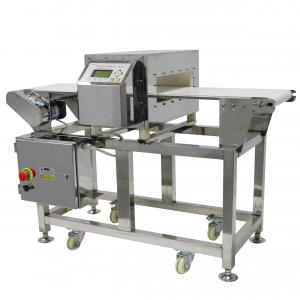
Add to Cart
Metal Detection for Food Products / Food & Pharmaceutical Metal Detection Systems / Food grade metal detector
According to Quality Assurance & Food Safety Magazine, all general purpose nonferrous metal detectors work in the same way:
When a particle of metal passes through the system:
Protecting your brand in the marketplace is one of the most important functions a food manufacturer performs. But all the investment to establish a reputation for product quality could be lost in the event of one safety recall. Developing and maintaining an effective, verifiable inspection program is no longer an option for processors. Metal detection is an effective and relatively inexpensive method of protecting your customers and your brand. While price, delivery and other commercial considerations are important, technical performance must be the primary factor when evaluating a metal detector to trust with your brand reputation.
Start by evaluating your inspection area. Is it wet or dry? What are the variations in temperature? Selecting a metal detector suited for your operating environment is critical. Water intrusion into the electrical components is one of the most common causes of metal detector failure. If there is a wash down regimen in the plant, is it high or low pressure? An IP65 wash down rating means that the metal detector can withstand low-pressure wash down with ambient temperature water. An IP69K rating means sustained high temperature and pressure. But beware: these ratings are typically self-reported. The manufacturer's reputation in the industry for the ability to withstand wash down can be a good indicator.
Does the wash down include caustic agents? If so, careful attention should be given to the specific alloy of the stainless steel used for the metal detector's case. Type 316L is more resistant to these caustic agents.
For dry environments, is the finish of the metal detector painted? Placing a painted surface in the product stream could eventually contaminate your products with chips of paint.
Also consider impact resistance. Plastic covers and membranes are subject to wear or impact penetration. A robust display screen and keyboard avoid downtime and parts replacement costs
Sensitivity reference
| Details Tunnel size | 40*12cm | 40*15cm | 40*20cm | 50*15cm | 50*20cm | 50*25cm | 50*30cm |
| Sensitivity Fe(mm) | 0.8 | 1.0 | 1.2 | 1.0 | 1.2 | 1.5 | 2.0 |
| Sensitivity SUS(mm) | 1.5 | 2.0 | 2.5 | 2.0 | 2.5 | 3.0 | 3.5 |
| Detection height | 120 | 150 | 200 | 150 | 200 | 250 | 300 |
| Detection width | 400 | 500 | |||||
| Belt speed |
10-35 meters per minute adjustable | ||||||
| Alarm method | Light and sound and optional reject | ||||||
Optional reject 1 :Push rod
Optional 2 flap drop
Optional 3 Air blast



